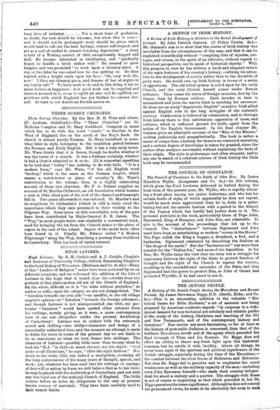THREE SURRE It CHURCHES.
Three Surrey Churches. By the Rev. H. R. Ware and others. (F. Lasham, Guildford.)—The "Three Churches" are St. Nicholas Compton and St. Mary Guildford. Compton (a name which has to do with the word " combe " so familiar in the West of England) lies on the south of the Hog's Back. Its church is almost purely Norman. St. Mary Guildford is some- what later in style, belonging to the transition period between the Norman and Early English. But it has a very early tower. Mr. Ware thinks that it is Saxon, though he doubts whether it was the tower of a church. It was a fortress certainly, whether it had a church attached to it or no. (It is somewhat upsetting to be told that " belfry " has nothing to do with bells. "It is a modern form," says Mr. Ware, "of the old English word 'berfray,' which is the same as the German berefrit, which means a watch-tower or place of security.") Mr. Ware's contribution to the volume, then, is a highly interesting account of these two churches. Mr. P G. Palmer supplies an account of St. Martha Chilworth, an old foundation which became a rain in 1846, when part of the roof of the chancel and transepts fell in. Two years afterwards it was restored. St. Martha's and its neighbour St. Catharine's (which is still a ruin) owed the importance which they once possessed to their vicinity to the Pilgrims Way. Some notes on this remarkable relic of the past have been contributed by Major-General E. R. James. The "Way," as most people know, was originally a commercial track, used for bringing the tin from the Cornish mines to the place of export in the east of the island. Ingots of the metal have often been found in it. Finally Mr. Palmer writes "A Modern Pilgrimage" along the Way, describing a journey from Guildford to Canterbury. This is a book of varied interest.


















































 Previous page
Previous page